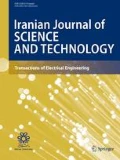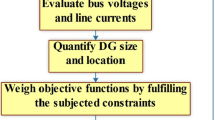Abstract
This paper develops a new management framework for optimal operation of the hybrid AC–DC microgrids incorporating renewable energy sources and storages. Hybrid microgrid consists of two parts of AC and DC to supply the AC and DC loads, respectively. The power exchange capability of hybrid microgrids between the AC and DC parts makes it possible to reduce the total microgrid costs, effectively. To make it a realistic analysis, a stochastic method based on cloud theory is proposed to model the uncertainty effects of wind turbine power, photovoltaic power, load demand and market price sufficiently. The proposed framework makes use of a new optimization algorithm based on flower pollination mechanism to minimize the total network costs through the optimal dispatch of the units. Also, a three-stage modification method is proposed to improve the population diversity and avoid the premature convergence. The performance of the proposed method is examined on the IEEE test system through two different operation scenarios.












Similar content being viewed by others
Abbreviations
- He :
-
Hyper entropy
- Iter :
-
Iteration number in algorithm
- Ex :
-
Standard deviation
- En :
-
Entropy
- \(C_{{{\text{G}}i}}^{t}\) and \(C_{{{\text{s}}j}}^{t}\) :
-
Cost of the ith RES and jth storage device at hour t
- \(C_{\text{Grid}}^{t}\) :
-
Price of utility at hour t
- d :
-
Length of the control vector
- f :
-
Cost objective function
- N T :
-
Number of scheduling time intervals in the study (in this paper 24)
- N s :
-
Number of storage devices
- N g :
-
Number of power units
- N Load :
-
Number of load levels
- n :
-
Total number of energy generation sources in MG
- \(p_{\text{Grid}}^{t}\) :
-
Active power bought/sold from/to the utility at time t
- \(p_{{{\text{G}}i}}^{t}\) and \(p_{{{\text{s}}j}}^{t}\) :
-
Active power output of the ith generator and jth storage device at time t
- \(P_{{{\text{Load}},k}}^{t}\) :
-
Load value in kth level of tth hour
- \(P_{m}^{{{\text{Inj}},t}}\)/\(Q_{m}^{{{\text{Inj}},t}}\) :
-
Active and reactive power injection in bus m at time t
- \(p_{{{\text{G}}i,\hbox{min} }}^{t}\) and \(p_{{{\text{G}}i,\hbox{max} }}^{t}\) :
-
Minimum and maximum active power production of ith RES at hour t
- \(p_{{{\text{s}}j,{ \hbox{min} }}}^{t} \,{\text{and}}\,p_{{{\text{s}}j , {\text{max}}}}^{t}\) :
-
Minimum and maximum active power production of jth storage device at hour t
- \(p_{{{\text{grid}},{ \hbox{min} }}}^{t} \,{\text{and}}\,p_{{{\text{grid}},{ \hbox{max} }}}^{t}\) :
-
Minimum and maximum active power production of the utility at hour t
- Pcharge (Pdischarge):
-
Permitted rate of charge (discharge) through a definite period of time Δt
- Pcharge,max (Pdischarge,max):
-
Maximum rate of charge (discharge) during definite period of time Δt
- \(P_{i}^{{{\text{Line}},t}}\) :
-
Amount of active power flow in line i at time t
- \(P_{i,\hbox{max} }^{\text{Line}}\) :
-
Allowed maximum power flow at line i
- pro :
-
Switching probability parameter
- Rest :
-
Scheduled spinning reserve at time t
- r i :
-
Random number with uniform distribution between 0 and 1
- \(S_{{{\text{G}}i}}^{\text{on}}\) and \(S_{{{\text{G}}i}}^{\text{off}}\) :
-
Start-up/shutdown costs for the ith RES unit
- \(S_{{{\text{s}}j}}^{\text{on}}\) and \(S_{{{\text{s}}j}}^{\text{off}}\) :
-
Start-up/shutdown costs for the jth storage device
- z t i :
-
Status of the ith unit at hour t
- Z g :
-
ON/OFF status of RESs
- V min /V max :
-
Minimum and maximum values of voltage
- V/δ :
-
Voltage magnitude/phase
- Wess,min (Wess,max):
-
Lower (upper) bounds on the battery energy storage
- W tess :
-
Battery energy storage at time t
- u :
-
Membership cloud of L
- X :
-
Control variable (or solution vector in CSA)
- X best :
-
Best solution in the algorithm
- x i,j :
-
jth element of the ith control vector Xi
- Y/θ :
-
Magnitude/phase of line admittance
- Ψ :
-
Levy movement
- M pop :
-
Mean value of the population
- r k :
-
Random number in the range of [0,1]
- ηcharge (ηdischarge):
-
Charge (discharge) efficiency of the battery
References
Avatefipour O, Nafisian A (2018) A novel electric load consumption prediction and feature selection model based on modified clonal selection algorithm. J Intell Fuzzy Syst 34(4):2261–2272
Baziar A, Kavousi-Fard A (2013) Considering uncertainty in the optimal energy management of renewable micro-grids including storage devices. Renew Energy 59:158–166
Eghtedarpour N, Farjah E (2014) Power control and management in a hybrid AC/DC microgrid. IEEE Trans Smart Grid 5(3):1494–1505
Han X, Zhang H, Yu X, Wang L (2016) Economic evaluation of grid-connected micro-grid system with photovoltaic and energy storage under different investment and financing models. Appl Energy 184:103–118
Hu MC, Lu SY, Chen YH (2016) Stochastic programming and market equilibrium analysis of microgrids energy management systems. Energy 113:662–670
Kamankesh H, Agelidis VG, Kavousi-Fard A (2016) Optimal scheduling of renewable micro-grids considering plug-in hybrid electric vehicle charging demand. Energy 100:285–297
Kamel RM, Nagasaka K (2015) Effect of load type on standalone micro grid fault performance. Appl Energy 160:532–540
Kavousi-Fard A (2017) Modeling uncertainty in tidal current forecast using prediction interval-based SVR. IEEE Trans Geo Sci Remote Sens 99:1–6
Kavousi-Fard A, Khodaei A (2016) Efficient integration of plug-in electric vehicles via reconfigurable microgrids. Energy 111:653–663
Kavousi-Fard A, Abunasri A, Zare A, Hoseinzadeh R (2014) Impact of plug-in hybrid electric vehicles charging demand on the optimal energy management of renewable micro-grids. Energy 78:904–915
Kavousi-Fard A, Abbasi A, Rostami MA, Khosravi A (2015a) Optimal distribution feeder reconfiguration for increasing the penetration of plug-in electric vehicles and minimizing network costs. Energy 93:1693–1703
Kavousi-Fard A, Niknam T, Fotuhi-Firuzabad M (2015b) Stochastic reconfiguration and optimal coordination of V2G plug-in electric vehicles considering correlated wind power generation. IEEE Trans Sustain Energy 6(3):822–830
Kavousi-Fard A, Niknam T, Fotuhi-Firuzabad M (2016) A novel stochastic framework based on cloud theory and θ-modified bat algorithm to solve the distribution feeder reconfiguration. IEEE Trans Smart Grid 7:120–131
Moeini-Aghtaie M, Abbaspour A, Fotuhi-Firuzabad M, Hajipour E (2014) Multiagent genetic algorithm: an online probabilistic view on economic dispatch of energy hubs constrained by wind availability. IEEE Trans Sustain Energy 5(2):699–708
Papari Behnaz, Edrington Chris S, Bhattacharya Indranil, Radman Ghadir (2017a) Effective energy management of hybrid AC–DC microgrids with storage devices. IEEE Trans Smart Grid 10(1):193–203
Papari B, Edrington CS, Kavousi-Fard F (2017b) An effective fuzzy feature selection and prediction method for modeling tidal current: a case of Persian Gulf. IEEE Trans Geosci Remote Sens 55(9):4956–4961
Papari Behnaz, Edrington Chris S, Gonsoulin David (2019) Optimal energy-emission management in hybrid AC–DC microgrids with vehicle-2-grid technology. J Renew Sustain Energy 11:134–142
Saravanan S, Ramesh Babu N (2017) Analysis and implementation of high step-up DC–DC converter for PV based grid application. Appl Energy 190:64–72
Shahcheraghi A, Piltan F, Mokhtar M, Avatefipour O, Khalilian A (2014) Design a novel SISO off-line tuning of modified PID fuzzy sliding mode controller. Int J Inf Technol Comput Sci (IJITCS) 6(2):72
Taherpoor H, Niknam T, Kavousi-Fard A (2015) A novel stochastic framework for energy management in renewable micro-grids considering uncertainty of measurement and forecasting. J Intell Fuzzy Syst 28(3):999–1008
Teimourzadeh Baboli P, Shahparasti M, Parsa Moghaddam M, Haghifam MR, Mohamadian M (2014) Energy management and operation modelling of hybrid AC–DC microgrid. IET Gen Trans Distrib 8(10):1700–1711
Yang XS (2012) Flower pollination algorithm for global optimization. In: Durand-Lose J, Jonoska N (eds) Unconventional computation and natural computation: 7445. Springer, Berlin
Author information
Authors and Affiliations
Corresponding author
Rights and permissions
About this article
Cite this article
Askari, M., Niknam, T. An Effective Stochastic Approach for Optimal Energy Resource Management in Hybrid AC–DC Microgrids. Iran J Sci Technol Trans Electr Eng 44, 835–848 (2020). https://doi.org/10.1007/s40998-019-00266-8
Received:
Accepted:
Published:
Issue Date:
DOI: https://doi.org/10.1007/s40998-019-00266-8




